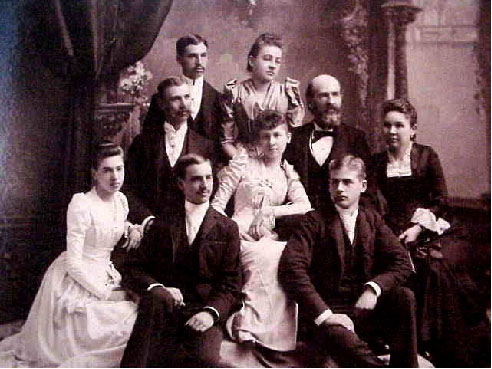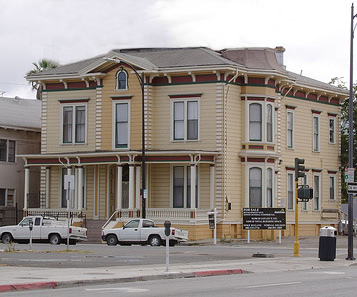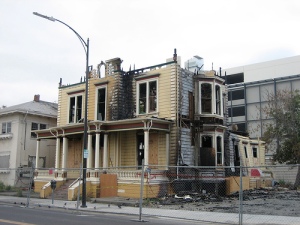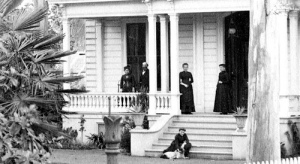By Jennifer Emmer, Fierce Preservationist

The Houghton-Donner Family, on the front porch of their glorious Victorian, late 1880s. This view is of its original location ~ the corner of Julian and North Third Street, San Jose, CA. It was moved to its present location in 1909.
On July 19th, an irreplaceable piece of San Jose history went up in flames.
SAN JOSE, CALIFORNIA: The 126-year-old Houghton-Donner House, built for a member of the Donner party succumbed to fire, turning centuries worth of California and San Jose history, and at least a decade worth of contentious redevelopment arguments, into ashes.
Personally, I am deeply saddened by the loss of the house, as I was present for many discussions of its fate during Preservation Action Council meetings in San Jose at the Petit Trianon, another downtown beauty.
By the time firefighters arrived shortly before 4 a.m., the “highly suspicious” blaze had fully engulfed the Houghton-Donner House on North Fourth and East St. John streets. Preservationists and developers later tried to carefully dismantle the 5,000-square-foot home’s charred facade to see if it could be saved and incorporated into other buildings.
The house is considered by some to be “the most historic building in San Jose,” Fire Chief Guerrero said. The investigation into what sparked the blaze is ongoing.
The house was built in 1881 for Eliza Donner – a survivor of the Donner Party, a group of early California settlers caught in a deadly blizzard in 1846 trying to cross the Sierra – and her husband Sherman Otis Houghton, San Jose’s fourth mayor, a lieutenant colonel in the Civil War and a Republican member of the U.S. House of Representatives. The home embodied the Victorian architecture of the time and was placed on the National Register of Historic Places in 2002.
Not only was the building a significant piece of California history, it was an aesthetically pleasing part of the urban fabric of downtown. It always looked a little sad, not being used to its full potential. However, the building did receive an attractive “painted lady” paint job, while it languished.
San Jose police were the first to arrive on the scene, escorting squatters from the building. While some older downtown homes have been expensively rehabilitated, others are largely vacant except for homeless people who sneak into the buildings at night and apparently set fires for heat and cooking.
Fire Chief Guerrero said he considered the fire to be suspicious, due to the fact that the Victorian was boarded up with no electricity and no gas. Police had received complaints about squatters using the Houghton Donner House after Keith Watt sold it in 2005.
Both Henry Cord, a representative of current owner Tony Baig, and former owner Keith Watt said they had done everything possible to keep unwelcome people out of the home. Although the windows were boarded up, people apparently continued to break in.
Why does San Jose leave its historic homes vacant for so long, turning them into attractive shelters for squatters?
The plan to make the home a “vibrant place where people live” was moving forward, Cord said. Ironically, a meeting about moving the home to the Hensley Historic District had been scheduled for Thursday. [Current owner] Baig wanted to move the home farther north on Fourth, rehabilitate it and turn it into condos.”
I’ve been working for a year and half to two years trying to save the house,” Cord said. Keith Watts and the Preservation Action Council vigorously fought a 2002 city proposal to move the home to the Hensley District to make room for a parking structure on the corner of Fourth and St. John. Although they eventually stopped the plan, the fight drained the money that Watts had planned to use to rehabilitate the home. He ultimately sold it.
[From the Mercury News, 7/20/2007]
Cord spent at least a year and half working with community groups to gain support for the renewed idea of moving the home. The application to do so is currently on file with the city.
“It has been a real hot potato,” Bellue said. But Cord believed he had the city and community support necessary to make the move this time. Baig made concessions to community demands, agreeing to keep the house as a home instead of turning it into commercial real estate. Bellue said the Preservation Action Council has remained opposed to moving the building but had been rethinking its stances in recent years.
For more on what can be done in light of the fire, see: http://www.sanjoseca.gov/planning/Historic/





